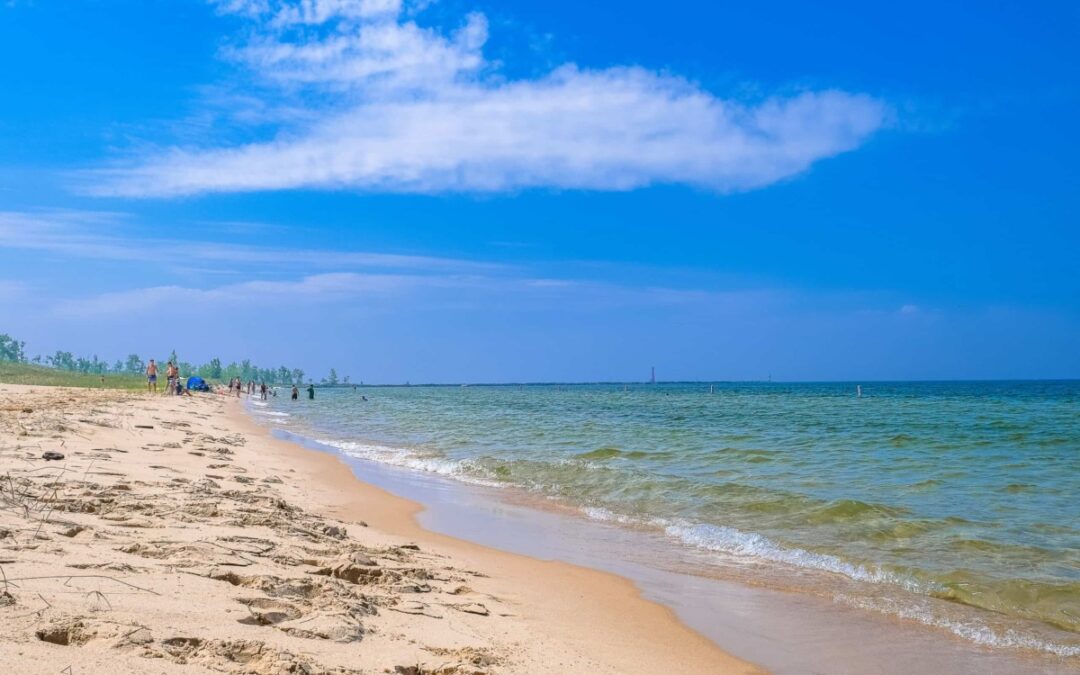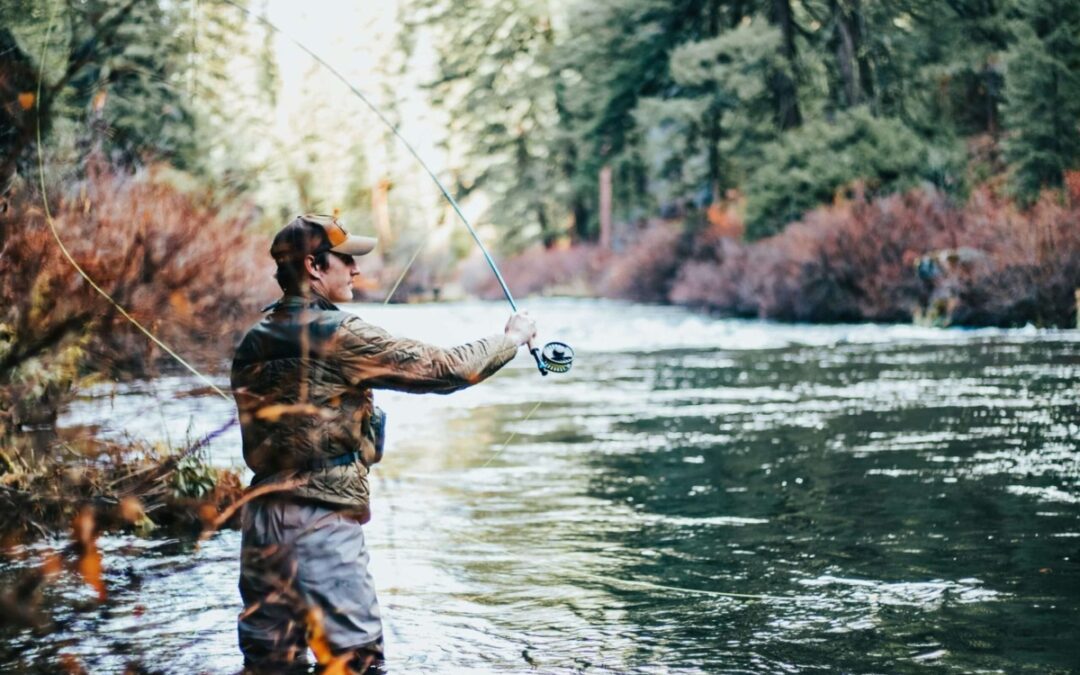
Ready to hit the trails? Check out our complete guide to backpacking in Michigan. (Ahmet Kurt/Unsplash)
Check out our tips for beginners and experts alike to get you started on backpacking in Michigan this summer.
If you’re looking to go backpacking in Michigan this summer, we’d argue that there’s no better state to do it in. After all, what other state gives you basically unlimited access to the largest sources of freshwater in the entire world? Enough said.
Backpacking might be something many people associate with fresh-out-of-college students or young adults trekking through Europe, but anyone at any age can give backpacking a try. At its core, backpacking simply means packing the essentials you need to survive in a backpack and spending time (day and night) outdoors. You can backpack for a few days or spend weeks camping and hiking—the fun part is, it’s up to you what your backpacking journey looks like.
If you’re ready to try something new this summer, here are some tips for backpacking in Michigan.
Where to go backpacking in Michigan
First things first—where exactly should you start backpacking in Michigan? If you’re heading out for a day hike only, that’s certainly a lot simpler, but if you plan on overnight camping, you’ll need to do some research ahead of time.
There are two general ways to enjoy backpacking in Michigan:
Free backpacking (dispersed camping) on Michigan state land
According to the Michigan DNR, backpacking, or dispersed camping, is free, legal, and permitted on any Michigan state forest land as long as the site is located more than one mile from a state forest campground. You can also check the full rules and download a dispersed camping registration card, which must be displayed on your campsite the entire time you stay, on their website.
Here are some additional rules that must be followed:
- Campsites cannot be located in a state park, recreation area, state forest campground, or state game area and must be located more than one mile from state forest campgrounds.
- The campsite or adjacent area cannot be posted “No Camping.”
- A backpacking registration card must be prominently posted at the campsite for the duration of the stay. It’s your responsibility to ensure that the registration card remains legible. Placing the card in a zip-top bag is recommended.
- State land rules must be followed at all times.
Reserved backcountry camping
The other option for backcountry camping in Michigan is at an official backcountry campsite, which usually offers some type of amenity, like a fire ring or water. Backcountry camping requires a backcountry camping permit, which is $15 to obtain and costs $5 per person per night. Some campsites may have additional reservation fees attached to them, and if you’re entering a Michigan state park (or Lakeshore National Park), you’ll also need to pay to enter the park.
We found All Trails to be an excellent resource that provides a detailed look at all the available backpacking trails in Michigan. We also identified the following trails as ideal for backpacking in Michigan:
The Potawatomi Trail
Located near Pickney, Mich., this trail extends 17.4 miles on a loop (so no hike in or out options, making it safer) through wetlands and marshes and features a rustic hike-in campground. The campground has 10 spots, plus a vault toilet, fire rings, and a hand-operated water pump. Day-of reservations are accepted on a first-come, first-served basis, but advance reservations are recommended. Camping is permitted for one night only.
Waterloo-Pinckney Trail
For backpackers seeking a more rigorous hike, look no further than this 38.5-mile trail near Grass Lake, Michigan, which features miles of vistas, 10 inland lakes, views of the Chelsea-Pinchney area and countryside, diverse landscapes, and boardwalks. Hiking the trail can take days, but several campgrounds are provided along the route. You’re not permitted to make your own campsite, but you can reserve a spot online.
Pictured Rocks National Lakeshore
One of the most beautiful spots in all of Michigan, this national park near Munsing features nearly 100 miles of park trails, with more than 42 miles along the Northern Coast. There are 13 designated backpacking camping areas along the trails, which you can reserve online ahead of time. The campsites are rustic, and one is accessible only by boat.
There are plenty of trails to choose from, but some popular loops are: Mosquito River, North Country, and Chapel Rock Trail Loop. (Some of the trails were recently damaged in an April storm, so be sure to check ahead of time before you visit.)
Manistee River Trail
This 11+ mile trail system along the banks of the Big Manistee River between Tippy Dam and Hodenpyle Dam is popular for its waterfalls as well as its canine-friendly camping rules. Backpacking and camping information is released in May of each year, so check before you go.
The North Country National Scenic Trail
For the ultimate backpacking in Michigan adventure, check out the North Country National Scenic Trail, which extends 4,800 miles across eight states, including the Lower Peninsula of Michigan. The trails offer all levels of accessibility for long-distance hikers and day hikers alike. Whether you want to join a hiking group or hike alone in the remote wilderness, you will find something for you on this trail.
In Michigan, the Scenic Trail includes the Porcupine Mountains; Ottawa, Hiawatha, and Manistee National Forests; Pictured Rocks National Lakeshore; Craig Lake, Tahquamenon Falls, and Straits State Parks; Lake Superior State Forest; the Mackinac Bridge; the Jordan River Valley; and Yankee Springs and Fort Custer Recreation Areas. One of the most popular Michigan backpacking trails is the Yankee Springs Segment, which is a 12.3-mile trail.
What you’ll need for backpacking in Michigan
The exact supplies you need for backpacking in Michigan will depend on where you hike, camp, and sleep, as well as what time of year you go, but here is a general list to get you started:
- Water-resistant backpack
- Hiking boots
- Food and cooking supplies (stove and fuel, if needed)
- Water bottles
- Water treatment supplies, if needed
- Hygiene supplies
- Repair kit
- Emergency and first aid kit
- Any necessary permits displayed appropriately
- A physical map of the area
- Waterproof tent and sleeping bag
- Solar-charged camp lantern and headlamp
- Sun protection (sunscreen, hat, protective clothing)
- Personal amenities
- Extra socks
- A warm outer layer
- Raincoat/jacket
- Trash bags for waste removal
- Bear supplies, including food storage and repellent, if in bear areas
- Insect repellent, protective clothing, and emergency allergy medication
During Hunting season (Labor Day-March 31), it’s also recommended to wear an orange hat or vest for safety. And of course, always check your planned arrival site for any specific rules about what you can and can’t bring—and what you can’t leave behind, in case you need to prepare for that too.
What time of year is best for backpacking in Michigan
The beautiful thing about backpacking in Michigan is that it’s truly a year-round camping destination. However, that being said, in general, backpacking during the late summer to mid-fall months means fewer bugs and more manageable, consistent temperatures. The high insect season in Michigan typically runs from late May through September, so it may be worth contending with slightly lower overnight temperatures if the trade-off is fewer bugs.
Backpacking in Michigan’s Upper Peninsula at springtime can be absolutely breathtaking with views of the waterfalls due to thaw and snowmelt, as well as a refreshed ecosystem after winter hibernation. (Check before you go, because not all trails open early enough in the spring.)
If you’re planning on backpacking on any trails near shorelines, know that trail conditions can be unpredictable due to the lakeshore weather—you should also be prepared for high winds and potential storms.
Guided group backpacking in Michigan options
There’s a lot that can go into backpacking, especially if you’re a beginner, so you may be excited to know that you can also join a guided group backpacking trip. That way, you can learn the ropes (sometimes literally) of backpacking, have safety in numbers, and gain some confidence before striking out on your own. Or, just stick to the group trips because frankly, they sound like a blast.
Here are some beginner (or expert) friendly guided backpacking groups in Michigan to check out:
- Porcupine Mountains Backpacking: These guided adventures will take you camping on the shores of Lake Superior and hiking through the Porkies of Michigan. The trips are described as beginner-level camping, incorporating backpacking and hiking, for 4 days and 3 nights. Meals are included, but you’ll need to bring your own camping supplies.
- Guided Outdoor Adventures: This company offers a variety of beginner-friendly and intermediate instructional, guided backpacking choices in areas near Detroit, such as Belle Isle, Pontiac Lake, and Pinckney State Parks.
- True North Outpost Overnight Trips in Copper Country: Groups of 2-10 can partake in a two-day, one-night escape in Michigan’s Upper Peninsula with all meals included and cooked by a guide. Sign me up!
- Wander Women Midwest: This consulting companies work with you to find an ideal group trip or design a custom individual trip for you.
- Backpacking Beyond: Headed by a knowledgeable and enthusiastic trail expert, these group hiking trips take you through popular spots and sell out quickly. Her trips are nationwide, so check the calendar for Michigan events.
Beginner Backpacking in Michigan Tips
Backpacking can be a great way to explore our great state. Whether you head out for just one night or pack for a full week away, there will always be something to learn. Have fun, stay open-minded in the process, and keep these tips in mind as you get started on becoming an expert backpacker:
- Don’t expect cell phones to work; let others know your itinerary and have a plan for what they should do if they don’t hear from you on your expected return date.
- Assemble a kit that works for you and your specific needs and goals. If you’re unsure whether an area can accommodate your needs, don’t hesitate to contact a Michigan DNR officer, who can discuss accessibility options with you.
- Be sure you’re aware of the rules and regulations about food storage depending on where you are headed—you may encounter bears and other wildlife in the backcountry, so keep a clean camp and store food in bear-proof food lockers available at state parks.
- Remember, elevation will play a role in how challenging a hike is, so somewhere like the Porkies will be more rigorous for most than the Lower Peninsula trails.
- Depending on where you’re going, many buildings and park amenities, including the visitor center, might be closed on federal holidays, so always check before you go.
This article first appeared on Good Info News Wire and is republished here under a Creative Commons license.
Related: Want to see wildflowers in Michigan? Head to these 12 trails

Out of the 103 state parks in Michigan, here are the top 10
Get to know the best state parks in Michigan, which offer an abundance of nature-based activities, from hiking and wildlife viewing to beaches and...

No license needed. How to fish for free in Michigan this week
Grab your fishing rods, sandwiches and, maybe, a few friends for a weekend of free fishing, as the state celebrates its second free fishing weekend...

Attention, anglers! Here are the 8 best fly fishing spots in Michigan
Get your waders out, because Michigan was voted the best state for fly fishing, and we've got the inside scoop on where to go! Fly fishing...

Summer safety on the water: Livingston County PFAS foam alert
Michigan health officials warn of PFAS-contaminated foam on waterways as summer approaches. Learn the risks and how to protect your family. With...

Glowing rocks in Michigan? What to know about ‘Yooperlites’
Most people do their rock hunting during the day, but you can't find "Yooperlites" until the sun goes down. Yooperlites are rocks that fluoresce in...







